The Ultimate Guide to Product OKRs
CHAPTER 1
Why we wrote this OKR guide
Have you ever heard the phrase, “Where you look is where you’ll go”?
If you’re golfing and looking at the sand trap, that’s likely where your ball will end up. If you’re driving and looking at the lane next to you, your car will start to veer in that direction. If you’re an employee at a startup or a larger established enterprise, where your team focuses its attention will impact the trajectory you will move in.
There are three essential pieces to consider here:
What is your team’s ultimate North Star? What is the destination you’d like to end up at over the long term?
What are steps you can take to move towards this star incrementally along the way?
What does “success” actually look like, tangibly, for both 1 and 2?
If you don’t find a way to align your team’s efforts and channel the collective energy and focus of the group on very specific outcomes, you are very likely going to end up in a situation akin to sailing to an unknown destination while dealing with holes in your boat and not having the right expertise on board to figure out which direction to head and how to fix the ship’s infrastructure.
There are many frameworks that can be used to channel your team’s focus towards a singular long-term outcome and sequentially shorter-term outcomes. For example:
V2MOMs (Vision, Values, Methods, Obstacles, and Measures): i.e. Salesforce uses these to align their business for success
BHAG (Big Hairy Audacious Goal): i.e. Amazon defined their BHAG as “to become the world’s most customer-centric company” - and used it to guide their team’s growth and expansion
SMART (Specific, Measurable, Achievable, Relevant, and Time-Bound): i.e. Apple uses this to set the company’s trajectory and focus the team’s efforts effectively to get there
OKRs (Objectives and Key Results): i.e. Google uses these to help the company set and measure both objectives and their outcomes (you can watch this presentation from Google Ventures to learn more about how Google sets OKRs from the inside-out).
We understand that navigating the complex realm of goal-setting and performance alignment within a team or organization can often feel like steering a ship through stormy waters without a compass. The journey to success can be filled with uncertainty and distractions. That's why we've crafted this in-depth guide, to provide you with a clear map and a guiding light in the form of OKRs (Objectives and Key Results). Our aim is to empower you with the knowledge and insights needed to chart a course toward your team's North Star, establish measurable milestones along the way, and ultimately, achieve tangible success.
CHAPTER 2
Objectives and Key Results 101
Defining OKRs
Objectives and Key Results, also known as OKRs, is a goal-setting framework used in businesses to align individual performance with overall goals in a measurable way. Ensuring all team members run in the same direction is no small task.
To make it easier, the Objectives and Key Results (OKR) framework can be implemented with the aim of securing a singular overall direction for the company and producing measurable results. In a nutshell, deploying OKRs is an effective way to set specific — and measurable goals for individual staff members that are specifically tailored to align with the overall strategic goals of the business. The OKR framework is a reliable method of improving individual performance and ensuring long-term goals are met.
OKRs are generally regarded as the most widely used, originally introduced in the 1980s by Andrew Grove, the former CEO of Intel, OKRs have been popularized by Google and adopted by companies including LinkedIn, Netflix, Twitter, Uber, Airbnb, in addition to becoming a gold-standard for smaller-scale startups all over the world.
Author John Doerr helped further popularize them with his book Measure What Matters and calls them “A kind of vaccine against fuzzy thinking.”
OKRs involve clearly defining two very specific things:
1. The Objective (THE WHAT)
What is your qualitative desired outcome?
What is your intent?
How can you describe this in a way that falls between overly ambitious and practical and very realistic?
How can you describe this in a way that is concise and can be immediately understood?
How can you describe this in a specific and tangible way that is not abstract or ambiguous, where reaching this outcome is binary (yes or no.)
Example Objective: Increase market share in the cloud services market
2. Key Results (THE HOW)
What are the specific, measurable outcomes that indicate progress towards reaching your main desired outcome?
How can you describe these in a way that is quantitative?
How can you describe these in a way that is time-bound?
How can you frame these with 3-5 Key Results (vs. too little or too many for it to be descriptive and/or trackable)?
Example Key Results: Key Result 1: Acquire 100 new enterprise customers for cloud services within the next quarter.
Key Result 2: Increase revenue from cloud services by 25% compared to the previous quarter.
3 considerations before working on your OKRs
1. Define the what, the who, and the North Star: Before even starting to define your OKRs, you should already know:
The problem you are focusing on solving
Who you are focused on solving this problem for
Purpose/Mission: Company North Star. Here are some examples from large enterprises and smaller lesser-known companies:
NASA: “To advance and communicate scientific knowledge and understanding of the Earth, the solar system, and the universe.”
LinkedIn: “To connect the world’s professionals to make them more productive and successful.”
Google: “To organize the world’s information and make it universally accessible and useful.”
The New York Times: “To seek the truth and help people understand the world.”
Yeti: “To build the cooler we’d use every day if it existed.”
Passionfruit: “To create inclusive clothing and accessories that enable you to show your pride all year round while giving back to our community.”
If you don’t have an understanding of these three things, you should not be defining your high-level business OKRs yet.
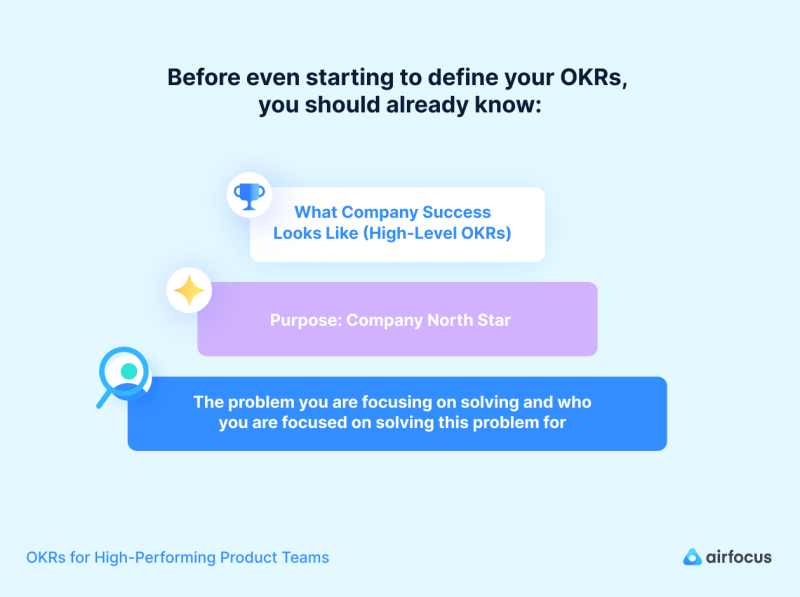
2. Levels of OKRs: There are different levels of OKRs and multiple ways these levels can be structured (depending on organizational structure, and number of products/teams.)
For example, you can have one set of OKRs that describe your business as a whole at a very high level (it’s important to nail these!), and, once you have a defined product vision and product strategy, another set of OKRs for the specific products you are building. This guide will focus on product OKRs.
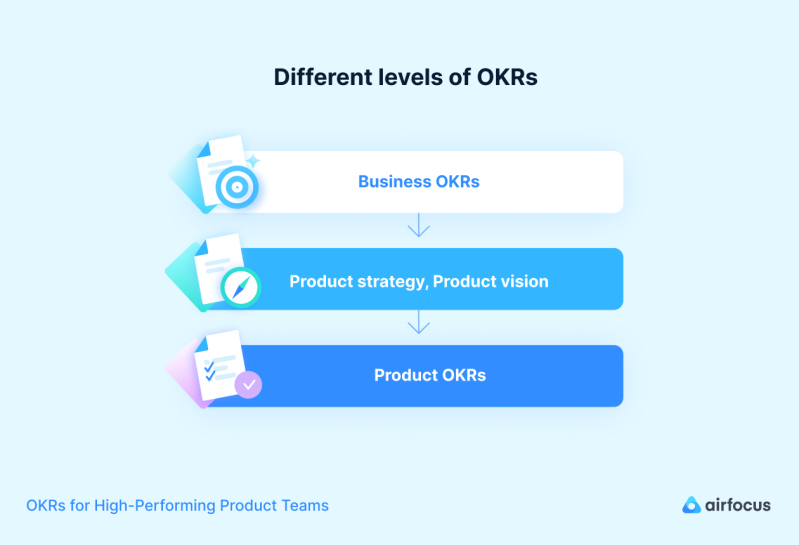
3. You can have OKRs for every team, and the whole business: OKRs can also be used to measure team objectives and key results. For example, some startups use OKRs internally to make sure each business unit is clear about what their individual objectives and key results are and to have visibility on how each unit contributed to the high-level business OKRs as a whole.
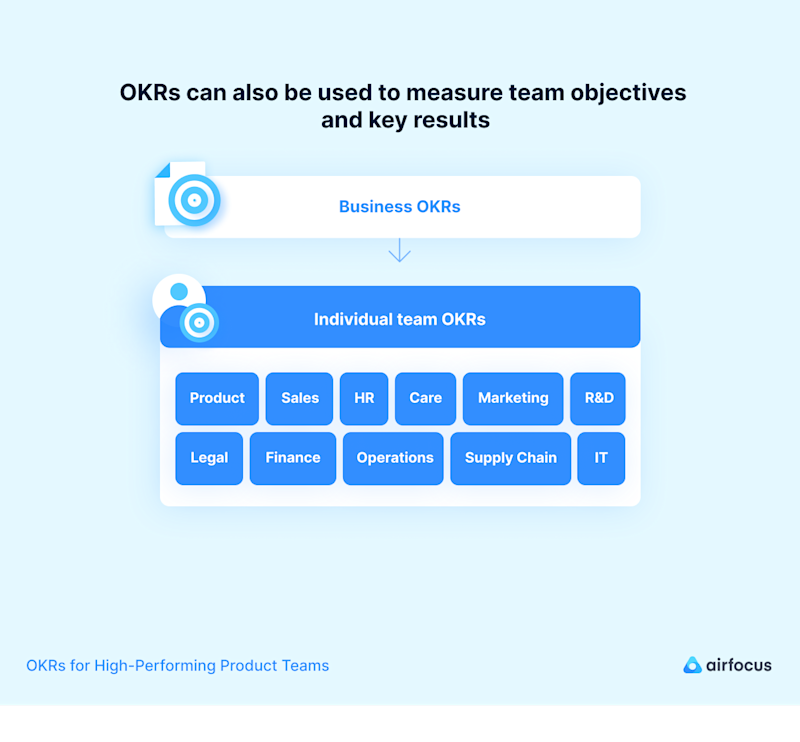
OKRs are important in product management because product managers sit at the intersection of business, technology, and user experience. Without clear business objectives and key results outlined, product managers will not have the ability to plug the product that they are leading the development of into the larger business
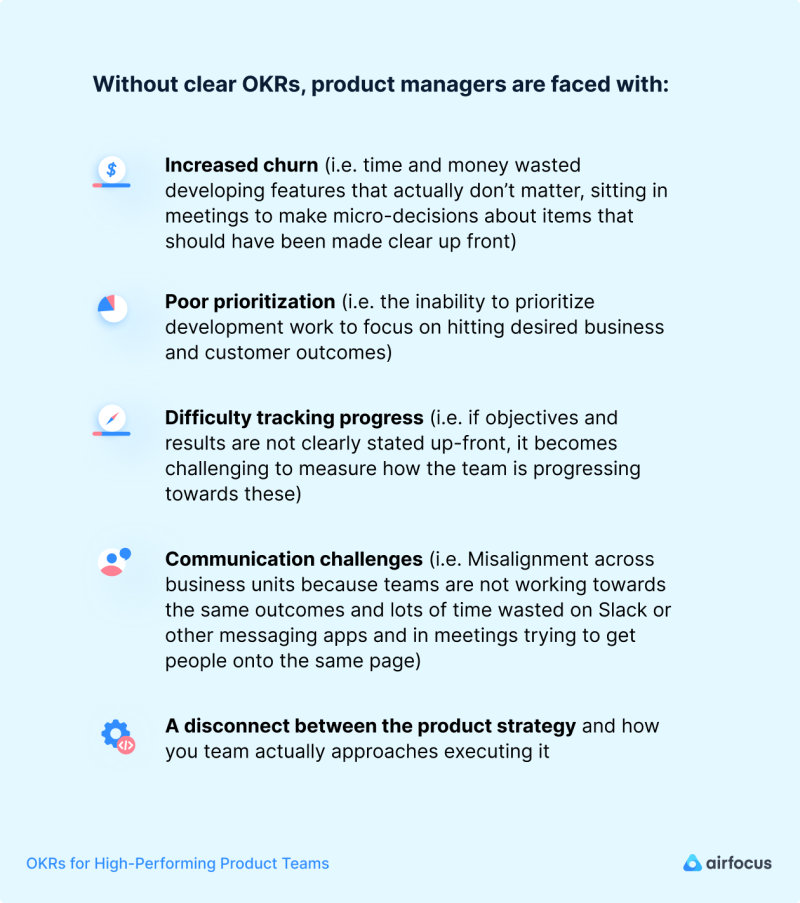
CHAPTER 3
Preparing your OKRs
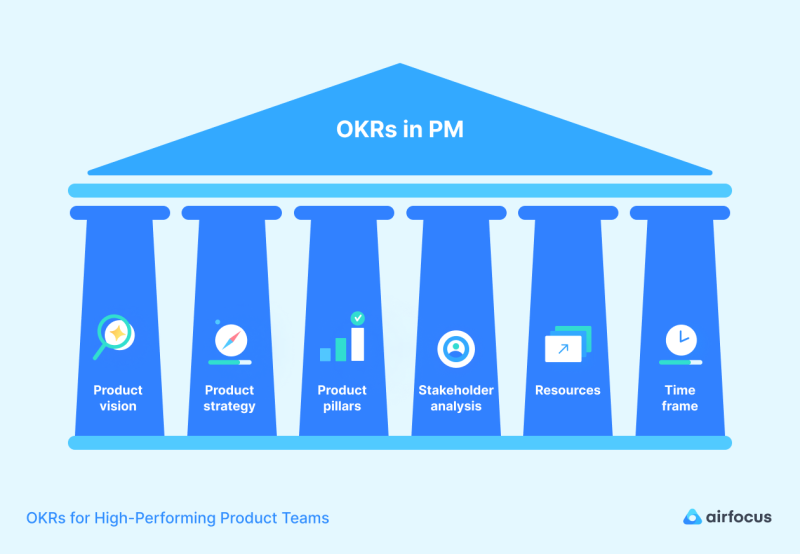
OKRs should not exist in a silo.
As a product manager, it is crucial that you consider areas of critical context as you set your OKRs. These include:
Product vision
Your product vision describes the future you are trying to create and is the reason why your product exists. It should be framed in a way that paints a common goal that aligns with your business OKRs and company North Star, is customer-focused, ambitious, meaningful, emotional, leveraging industry world trends, and is focused on a time frame that is 2-10 years out.
When it comes to your product vision, everyone on your team should be able to answer these questions:
How does it improve the lives of our customers?
What is the end game?
How does the work of individual team members contribute to a larger whole?
Does this incorporate thinking about potential externalities and how we will ultimately impact the world (in both positive and negative ways)?
Real-world examples of product vision
Apple iPod: “1000 songs in your pocket”
Airbnb: “Book rooms with locals, rather than hotels”
Uber: “Tap a button, get a ride”
Any product OKRs you set need to take your product vision into account and vice versa.
Product strategy
Your product strategy is the “HOW” that describes how you will achieve the product vision. It answers:
How will you achieve the product vision?
What approach will you take?
How will this help us to achieve our company goals?
How will this help us to achieve our product goals?
Real-world examples of product strategies
Superhuman: Reverse-engineering product-market fit (used PMF as a leading vs. lagging indicator and tweaked their product to optimize PMF with their stickiest user segment)
Twilio: Picking a wedge (initially started as a basic API to send SMS messages)
Calendly: Focusing on a specific part of the customer journey (just focus on making meetings more efficient vs. focusing on other aspects of “meetings” like meeting hosting)
Netflix: Picking key focal points (personalization, original content, watching experience, interactive storytelling)
Any OKRs you set need to consider your product strategy and vice versa.
For example (mock product strategy):
Win the shoe e-commerce market by focusing on:
Greater reach internationally
Personalized shoe-fitting experience
Key partnerships and high-profile endorsements
Mock OKRs:
Objective (Related to focal point #1 in product strategy):
To expand our e-commerce platform into new markets by offering localized content and products that appeal to local customers.
Key Result 1: Increase the number of monthly active users in the new markets by 25% by the end of Q3.
Key Result 2: Increase the number of products available on the platform in the new markets by 50% by the end of Q4.
Key Result 3: Establish partnerships with three local businesses in each market to promote the platform by the end of Q3.
Product pillars
Product pillars (also called product principles) describe the nature of your product (or product offering), identify what you believe in, and define what you think is most important that needs to be prioritized. They can help teams work in a more empowered way, make decisions faster, keep scope focused, and reduce development and decision churn.
Real-world examples of product pillars
Slack: Don’t make me think, be a great host, prototype the path, don’t reinvent the wheel, make bigger, bolder bets
Considering product pillars when establishing your OKRs ensures there is a fluidity between what you are aiming for and how you will prioritize decisions to get there.
Stakeholder analysis
Understanding all of the different business units and teams in your company and how each will have an impact on the success of the product or will be affected by it is also critical.
Any time you are doing anything with a team trying to build a product that improves people’s lives, win a National Championship, or prove that something that was previously thought to be impossible is, in fact, possible the people you bring in, the strengths of the relationships you build, and how well you can work together towards a common and clearly defined goal will matter more than the combined talent of individuals, a lofty vision, amount of funding you’ve got, or technological capabilities you have.
Thinking about your team and how key of a role this will play in you attaining the OKRs that you set, consider:
Who key team members are
Their domain expertise and scope of work
What outcomes do they care most about and why
What role do they play in product decisions (you can use frameworks like RACI (Responsible, Accountable, Consulted, Informed) and DACI (Driver, Approver, Contributor, Informed) to figure out who needs to be involved and to what extent in different contexts)
Taking into account key stakeholders and what role each of them plays in the bigger picture is valuable when setting OKRs because you want to strike a balance between OKRs that are too ambitious or too easy to attain and having the context of your team’s makeup, skillsets, scope of work, and responsibilities makes it easier to set the right kinds of OKRs and map out your approach to getting there.
Your team is also crucial in helping you set OKRs. This should always be a team effort and never rest on a sole team member’s shoulders.
Additionally, the exercise of setting OKRs can be a great tool to generate alignment within a team defining what you want to achieve and why that is important, working with each other to find a common language to express this, and clarifying where the team is headed and how each individual fits into this can all help to bring a team closer together.
Resources
What does your financial runway look like? How many resources do you have to accomplish your OKRs?
Not considering this is a critical mistake and can often lead to overly ambitious OKRs being set with no grounding in reality and feasibility based on your team�’s context and constraints.
Time frame
Realistically, how long will you have to achieve your objectives? Will this be a 1-year-out type of objective? Or 5-years- out? This is often based on your team’s financial runway, headcount, market conditions, and competitive landscape.
For a smaller company, this might look like a 1-year-out activity with incremental OKRs along the way (i.e. monthly). For a larger company, a 5-year-out plan might work better because there are so many teams involved, again with incremental OKRs along the way (i.e. annual and quarterly).
CHAPTER 4
Good vs. bad OKRs
OKRs can be defined in varying levels of fidelity and effectiveness.
Key considerations to create good OKRs
Objective:
Expresses a desired outcome
Strikes a balance between too aspirational and too realistic/easy to achieve (Google tries to set OKRs that are achievable 60-70% of the time to help strike this balance)
Is clear and concise - can be written as a one-liner (vs. an entire paragraph)
Is tangible (is not so abstract that you can’t fathom what it would actually look and feel like to achieve it)
Provides clear value for your company/product
Key Results:
Are directly connected to the objective
Can be measured in a quantitative way (i.e. did X result happen? Yes or no?) and in a timely manner (i.e. there is no significant lag or delay between a result happening and your team having to measure that result)
Are clear and concise - can be written as a one-liner (vs. an entire paragraph)
Common pitfalls when drafting OKRs
Not involving your team when drafting them
Too ambitious - practically impossible to achieve which makes it difficult to garner buy-in
Too realistic and easily attainable - attaining them doesn’t provide significant value and simply ticks a box (“sandbagging” or “business-as-usual” OKRs)
Too vague and fuzzy to understand tangibly
Too disconnected from the company's North Star or desired outcome
Cannot be measured
Are not time-bound
Are not oriented around “doing” and are framed more as “talking about/around doing”
Not sharing them publicly and keeping them in a place that is visible and that can be regularly checked in on
Having too many
Setting them for too far into the future
Examples of good vs. bad OKRs
To paint a tangible picture of what bad vs. good OKRs look like and common pitfalls to avoid, we've laid out several within the context of making breakfast with commentary embedded.
Examples of bad breakfast OKRs
1. “Who Cares” OKRs: Not specific or aspirational enough and read like a to-do list”
Objective: Make breakfast (Too vague and not meaningful, the desired outcome should be more specific and more aspirational)
Key Result #1: Crack 5 eggs (Sure this needs to happen - but if you crack 4 eggs vs. 5 wouldn’t you have still made breakfast and reached your objective?)
Key Result #2: Toast 2 slices of bread (Same here - you could still have “made breakfast” even with no toast involved)
Key Result #3: Put some jam on the toast (Same here - what if this was peanut butter instead of jam? Would you still have achieved your objective?)
2. “Too lofty” OKRs: Clearly unattainable”
Objective: Revolutionize the breakfast industry (Probably not possible if you are just starting out and want to make breakfast by yourself this morning - it’s unrealistic and not actionable)
Key Result #1: Launch a new breakfast product that is 50% healthier than any existing product (Unlikely to happen with a single individual making breakfast)
Key Result #2: Increase market share in the breakfast category by 25% (Unlikely to happen with a single individual making breakfast)
Key Result #3: Partner with 5 major grocery store chains to distribute the new product (Unlikely to happen with a single individual making breakfast)
3. “Disconnected” OKRs: Key results are disconnected from the main objective
Objective: Make a healthy and satisfying breakfast (Pretty good objective)
Key Result #1: Hire a breakfast marketing manager (Unlikely that this would help in achieving your objective)
Key Result #2: Increase breakfast sales by 10% (Unlikely that this would help in achieving your objective)
Key Result #3: Put breakfast photos on a billboard that is shown to 20% of people entering the city of Toronto on a major highway (Unlikely that this would help in achieving your objective)
Example of good breakfast OKRs
Specific, attainable, with key results that are connected to the objective
Objective: Make a healthy and satisfying breakfast
Key Result #1: Use at least 3 different colors of fruits and vegetables in the meal
Key Result #2: Increase protein so it takes up 50% of the plate
Key Result #3: Increase healthy fat to 1 tbsp
CHAPTER 5
Setting OKRs within your organization
When setting OKRs within your product team and organization, it’s important to understand what processes are already in place, for example:
Do you work at a larger org where there is already an OKR-setting, review, and committal process?
which key stakeholders you’ll need to involve (to gather their input and form your OKRs in a collaborative, focused way)
How these OKRs fit into the larger organizational desired outcomes.
OKRs might look quite different in a larger organization vs. a smaller organization and your context is crucial to consider.
For example, at a small startup, OKRs are often focused on building and launching your first product, acquiring early customers, and achieving initial revenue goals to stay afloat.
They need to be realistic and achievable based on your limited resources and smaller team size. They’ll likely be drafted more collaboratively because everyone is more likely to be wearing multiple hats and working in a close-knit, cross-functional manner. Your OKRs would also most likely need to be set and adjusted more frequently in order to stay nimble and move in an agile way.
At a large organization, your OKRs are likely to be broader in scope and include goals related to market share, customer retention, and profitability. With more resources, OKRs are likely to be more ambitious in nature. With larger teams and organizational structures in place, OKRs at a larger company are often set at the department and team levels with each contributing to the overall company objectives.
Because larger companies require a lot of people to communicate in order to work in the same direction, they often have more structured approaches and processes in place to set OKRs in a formal way with longer planning cycles (i.e. annual OKRs vs. monthly or quarterly OKRs).
Key considerations when setting OKRs for all organizational sizes
Having clear ownership and responsibility for each OKR
This is probably the biggest area that can cause confusion if not decided on early on in the process. Every single OKR that is set should have a person’s name beside it who is accountable for tracking and delivering that OKR and raising the flag to communicate cross-functionally if the OKR is at risk and why.
Some teams assign co-owners to OKRs which is fine if communication is crystal clear, but often co-ownership can cause confusion so we would recommend a single person be responsible for each OKR.
Creating a system to gather input from key individuals to define your OKRs
Planning how to gather input from key team members goes a long way. Your OKRs should be drafted collaboratively vs. by one person in a silo.
This can be done by identifying key contributors in advance and providing appropriate guardrails to frame what you are trying to do (essential context and constraints discussed above like resources, time frame, how this all fits into your larger company North Star, product vision, etc.) and examples of good and bad OKRs (feel free to use the breakfast example above).
This process could look like this:
OKR owner defines key stakeholders that they need input from
An outline is created that frames the problem and desired outcome (a good OKR that fits into the current context)
A sync is organized with these key stakeholders and the outline is sent to them in advance so they can come into the discussion informed and what they are expected to contribute is clear
OKRs can be set offline after this sync, and once complete, key contributors can look through each team’s OKRs to identify areas of ambiguity, misalignment, sandbagging, lack of focus, overlaps with other groups’ OKRs, and more.
In our experience, this will happen in very formal ways at large enterprises where you know your OKRs are going to be due at certain times of the year so you can get ahead and start to plan them early with your team, and can happen more informally at a higher frequency at smaller organizations.
Regardless of your situation, creating a system to gather input from others and making sure it is done in a format that prevents things from “going off the rails” is going to help you out in the long run.
Starting with long-term objectives
For example, set OKRs annually to begin with, and then break down quarterly OKRs based on this.
This can be approached in a way that is similar to a Now vs. Next vs. Later product roadmap where you set your longer-term desired outcomes and track back to fill in the sequential outcomes you desire along the way. Make sure that all OKRs that you set align with company goals. For example:
Annual Objective: Increase annual revenue by 20%.
Q1 Objective: Increase customer base by 15%.
Key Results:
Boost conversion rate by 10% for incoming leads.
Acquire 200 new customers this quarter.
Launch and promote a customer referral program, resulting in 50 referrals in Q1.
Q2 Objective: Increase average order value by 5%.
Key Results:
Upsell to 15% of customers, resulting in a 7% increase in average order value.
Introduce a premium product tier, with 20% of customers upgrading.
Launch a "Bundled Deals" campaign, resulting in 8% of customers choosing bundled options.
Q3 Objective: Launch a new product line and generate 10% of total revenue from it.
Key Results:
Launch a targeted online marketing campaign for the new product, resulting in $50,000 in sales this quarter.
Collaborate with influencers to promote the new product line, resulting in $25,000 in influencer-driven sales.
Launch the new product line in three international markets, generating $150,000 in international sales.
Q4 Objective: Increase customer retention rate by 10%.
Key Results:
Implement a proactive customer outreach program, resulting in a 20% feature usage increase.
Introduce a loyalty rewards program, to which 10% of customers sub by the end of the quarter.
Prioritizing which OKRs you are focused on each quarter
The number of OKRs you will be focused on achieving will depend on the size of your team and the stage of your company, but our rule of thumb is less is more. If you are focused on too many OKRs they will become diluted, will be difficult to track, and you will be less likely to achieve all of them.
You can also over-torque on this though and end up in a situation where you’ve got clear gaps in objectives and areas of responsibility to reach these objectives, so finding a healthy balance on this spectrum is valuable.
At a company level, this should be simple and clear (i.e. one set of annual OKRs that the entire team is aligned on). Individual team OKRs can be prioritized to fit into this. At the basic level, you need to understand: “Which OKRs are the most important to achieve and why?” You can use prioritization techniques like value vs. effort, RICE, the Eisenhower matrix, priority poker, MoSCoW, and more to help you answer this question (If you really want to get into the weeds here, you can also identify key planned OKRs vs. aspirational OKRs that keep the team stretched and motivated.)
REMEMBER: It’s important to remember WHY you are prioritizing your OKRs in the first place - they need to be tied to action. Don’t overdo your OKR processes and forget to actually act on them!
Having a clear communication and review plan around your OKRs
Each person at your company should understand:
Company-level OKRs
Their individual team OKRs
How the work that they do every day contributes to one or more of these
OKRs should be presented incrementally in a time-boxed fashion throughout the year (i.e. annually and quarterly), be transparent, and be posted in places that are immediately visible (i.e. physically in your office or digitally in core information “hubs” and virtual bulletin boards like Confluence, Notion, internal websites, and other tools that people see and access on a daily basis.) They should also be included in key presentations like company updates, roadmap, and scope reviews, as well as project planning. Bottom line: they should be clear, and easy to see and everyone in your company should be able to repeat your high-level OKRs verbatim.
Real-world examples of OKRs
Now that you are sufficiently hungry (to learn more) and have more context around what good vs. bad OKRs look like in a general sense, let’s dig into some real-world examples of good OKRs:
Apple
Objective: Reduce the company’s carbon footprint and become carbon neutral by 2030.
Key Result #1: Transition to 100% renewable energy for all facilities and data centers.
Key Result #2: Use only low-carbon or recycled materials in our products.
Key Result #3: Invest in developing innovative carbon renewal technologies.
Google Ventures
Objective: Accelerate blogger revenue growth.
Key Result #1: Launch the “monetize” tab for all users.
Key Result #2: Implement AdSense Host Channel Placement Targeting to increase RPMs by xx%.
Key Result #3: Launch 3 revenue-specific experiments to learn what drives revenue growth.
Source: Google Ventures: How Google Sets Goals talk
Airbnb
Objective: Expand experiences and destinations offered.
Key Result #1: Expand Experiences to 1000 destinations by the end of 2018.
Key Result #2: Launch 3 new Experience Categories (Airbnb Concerts, Social Dining, and Adventures.)
Key Result #3: Expand Social Experiences.
CHAPTER 6
Tracking and Measuring OKRs
Once you’ve aligned on your OKRs, they’ve been communicated, and you know who is responsible for delivering each, setting up a system to help you track and measure your progress in a way that is accurate and low-lift (i.e. doesn’t require a month to compile copious amounts of data manually from different sources), and also takes into account cross-functional dependencies will be critical to help you understand:
Where you’re at
How to adjust course if necessary
Tips to stay on track
Make sure your OKRs are clear, focused, and tangible from the get-go - this will make them easier to track.
Keep a close eye on any changes at the business level, with your customers, and with your team. These are typically the two areas that will impact your OKRs the most. For example, if you have a major layoff, if the business direction changes, if your customers’ behaviors are changing drastically (i.e. like many companies saw during the pandemic) you might need to reassess how feasible some of your OKRs are.
Monitor progress and review this regularly. If you have quarterly OKRs, you shouldn’t just be tracking these quarterly - you should be following how you’re tracking on a weekly basis.
Use data as your ally - if you can measure something quantitatively, do this. If you can’t, think of creative ways you can collect evidence to understand how you are tracking toward your objective.
Create error-handling systems to ensure that the data you are tracking is accurate (i.e. flags that let you know if there are any issues with your analytics systems or if critical information is missing that might be skewing your results).
Have risk-mitigation strategies and corrective actions in place - think of parallel paths to achieve your objectives up-front so that if something does go wrong (which it will), you have a step up in terms of dealing with it.
Communicate openly with your team and with other teams about how you are tracking and why - keeping information close to your chest or misinforming teams will not help anybody.
Collaborate. Bring key team members in to help prevent issues in advance, solve problems as they come up, and work together to “own” the results that the team is generating with the work you are doing. There might be a single person that is accountable for delivering an OKR but they really just represent the power and work of the larger team.
Be flexible. Things will undoubtedly change after your OKRs are set. Some of the variables you initially considered when drafting your OKRs will likely change and the ground will shift. Expect this. Plan for it to happen and know that you will need to adapt along the way.
When to adjust your OKRs
Setting and tracking OKRs is never perfect and there are times you will need to change either the objectives you have set, the key results you have aligned on, or both.
But how do you know when this is warranted? Here are some clues
Lack of progress
If you are not making any measurable progress towards your objectives despite your efforts, it may be time to reevaluate your approach - but to do this well you need to identify what your blockers are first to come up with a strategic way to revamp your OKR.
Changing priorities
Business priorities can change quickly. We saw this at companies around the world during the pandemic. We see this when competitors make major moves and companies are forced to reposition themselves and adapt quickly to stay afloat, we see this when acquisitions happen. We see this when there are changes in leadership at companies. When these changes happen, be ready to assess whether or not your OKRs are still relevant.
New opportunities emerged
We don’t live in a static ecosystem - when the ground shifts, this often gives birth to new opportunities that may cause you to need to shift your OKRs slightly or through a full overhaul.
Lack of relevance
If it’s clear that your OKRs are not actually impacting the higher-level company OKRs and your team is just “going through the motions” it’s likely time to update them.
You’ve achieved them early
If you've already achieved your objectives sooner than you expected, good job! Now you should set new ones to keep your work aligned and purposeful.
Communicating results
Achieving an OKR should always be connected to moving a product forward toward your vision and the future you are trying to create. It’s not solely about “ticking a box” and how you communicate the impact of each OKR and how it’s connected to this vision is critical.
When measuring and tracking progress, having clear checkpoints along the way where you know your results will be communicated is helpful so you can organize yourself to be ready for these milestones; however, this isn’t always the case and sometimes you’ll need to communicate challenges or reasons to adjust course at varying frequencies.
Some of the things that can help you do this effectively are:
Having a clear framework for communicating results
What OKR does this relate to?
Why is this important?
What is happening?
Why is this happening?
Who does this impact?
What are we doing about it?
Making sure everyone has the appropriate context
This is important in order to understand what you are communicating and what is expected of them (i.e. Do you need their help in adjusting course? Or are you informing them that their work is impacted by one of your findings?)
Be as specific as possible
If you’re talking about the reasons why you’re not able to hit a key result, communicate the root of why this is happening; if you’re talking about what your team will do to adapt, don’t talk theoretically - speak to the specific actions key team members will take
Know your audience
Don’t invite people to meetings where you’re communicating progress who don’t need to be there, and make sure that the people who do need to be involved or informed are in the room (physically or virtually); blind-sighting teams and leaving key individuals out of important communications and having “too many cooks in the kitchen” can be an equally negative situation to helping you achieve your desired outcomes.
Communicate regularly
Having daily and weekly check-ins with your immediate team and check-ins quarterly or several times a quarter with larger groups is helpful to keep things on track and aligned.
Celebrate your wins
Did you reach an objective sooner than expected? Communicate this and celebrate with the team!
Recognize key contributions
Did several teammates really step up to the plate to help achieve a key result? Recognize these things regularly and publicly!
OKR scoring
Some companies score their OKRs - for example, Google often grades OKRs on a scale of 0.0 (the objective was not achieved, and not even partially) to 1.0 (the objective was fully achieved).
They use a rough rating scale with each key result being graded and then determining the overall objective achievement score based on a rough average. For example, for binary results like “Launch X new feature” 0 or 1 can be applied vs. for spectrum results like, “Open retail stores in 6 countries” and only 3 were opened, partial scores like 0.5 can be applied.
Google stated that they typically aim for 60-70% (0.6 to 0.7) across key results to land in the sweet spot between setting overly ambitious goals and ones that are not high enough.
Another way to approach this could be to use a colour-grading system. You can use “Red” (At risk), “Yellow” (On track with concerns), and “Green” (On track with no major concerns) to help communicate how we are doing in a way that is both visual and straightforward.
CHAPTER 7
Tools for Setting and Tracking OKRs
In product management, achieving alignment, focus, and measurable outcomes is paramount. Objectives and Key Results (OKRs) have emerged as a powerful framework to guide product teams toward success. Yet, the journey to effectively implement and manage OKRs requires the right tools, tailored to the unique needs of your organization.
In this chapter, we explore the pivotal role of OKR tools within the context of product teams. We delve into three distinct categories of OKR tools, each with its own set of advantages and considerations in order to help you make the right choice for your organization.
The 3 categories we will explore are:
Product management tools with OKR functionality
Dedicated OKR tools
General-purpose tools.
The best choice for your organization depends on your specific needs. However, for product teams, integrating OKRs within your product management tool is often the smartest move.
Product management tools with OKR functionality
Product managers are the architects of innovation, orchestrating the development of features, enhancements, and experiences that captivate users.
In this dynamic role, aligning your team's efforts with strategic objectives is not just desirable; it's essential. That's where dedicated product management tools equipped with integrated OKR functionality shine.
Imagine this: With a single glance, you can seamlessly bridge your product's vision and OKRs with the execution and product delivery. No more wrestling with spreadsheets or grappling with disconnected goals. Picture the possibilities when your OKRs are an integral part of your product management tool when the lines between strategy and execution blur to create a harmonious display of progress.
Pros and cons of product management tools with OKR functionality
Pros:
• Seamless alignment across teams: These tools facilitate seamless alignment between your product management objectives and your team's daily work. They bridge the gap between high-level strategy and on-the-ground execution, ensuring that everyone is on the same page.
• Unified workflow integration: With integrated OKR functionality, you can unify your entire workflow within a single platform. This means that not only your OKRs but also your product artifacts, roadmaps, and PM workflows are all connected, creating a holistic view of progress.
• Dynamic progress insights: These tools provide dynamic insights into your OKR progress. By connecting initiatives, epics, or tasks to key results, you gain real-time visibility into how your team's day-to-day work directly impacts your strategic objectives.
• Enhanced communication: Product management tools with OKR functionality enhance communication and transparency across teams. They empower team members to understand how their contributions fit into the broader company vision, fostering a culture of collaboration and accountability.
Cons: • While product management tools with integrated OKR functionality offer a seamless experience for product teams, they may not suit organizations with a pre-existing, dedicated OKR tool infrastructure.
• Additionally, some product management tools may require a learning curve for those new to the platform. However, these cons are often outweighed by the transformative benefits of aligning your product management efforts with OKRs in a single, unified ecosystem.
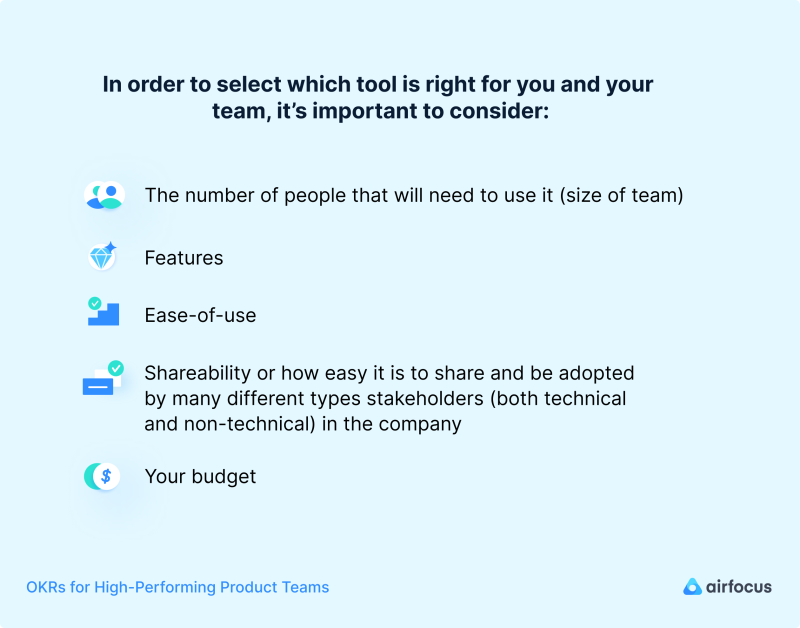
Examples of Product Management Tools with OKR Functionality
1. airfocus Objectives & OKRs app
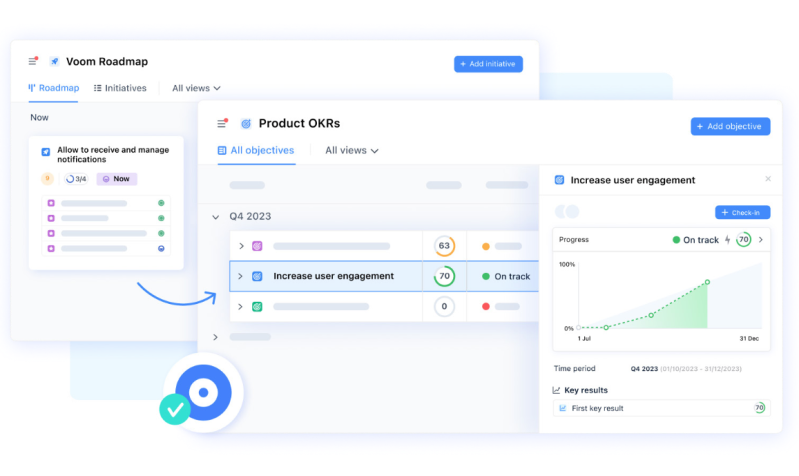
The airfocus Objectives app is a powerful addition to our modular product management software, designed to enhance the strategic alignment and execution of your objectives. It seamlessly integrates with existing airfocus workspaces, offering a dedicated space to manage your objectives and OKRs. The airfocus Objectives app stands as the best representation of the power and potential of product management tools with OKR functionality.
Pros:
Unified ecosystem for your product: No more struggling with spreadsheets or managing disconnected goals. The airfocus Objectives app allows you to effortlessly incorporate OKRs into your product management workflow. This unified ecosystem brings together all your product artifacts, from user stories to long-term company objectives, into one cohesive environment. It's the hub where you can gain a comprehensive view of your team's progress across all levels.
Link product work to OKRs to not lose sight of your strategy: Successful product management hinges on aligning strategic vision with daily execution. With airfocus Objectives, you can seamlessly link your product work, such as initiatives, epics, or tasks, directly to your key results. This integration ensures that every piece of day-to-day product work contributes directly to your overarching strategy, creating a harmonious synergy between your vision and execution.
Real-time insights and check-ins: The airfocus Objectives app empowers you to submit regular check-ins, providing real-time context for your OKR progress. This feature enables you to spot at-risk objectives and make timely adjustments, ensuring that you stay on course and meet your goals before the cycle ends. It's a proactive approach to managing your objectives, eliminating the need to rely on periodic reports or post-mortem analyses.
Enhancing organizational transparency: Transparency is the bedrock of trust within organizations. The airfocus Objectives app fosters organizational transparency by making OKRs widely accessible. This ensures that individual team members understand how their work directly contributes to the company's overall success. Such alignment creates a culture of accountability and shared purpose, driving your team toward success.
Implement any objective management framework: Track your goals and progress regardless of what process or framework you use. Benefit from airfocus' flexibility by customizing objective hierarchies, time periods, views, and fields to reflect how you plan and work.
Cons:
Modularity may take time to get used to: While airfocus Objectives offers incredible flexibility and customization options, its modularity may take some time to get accustomed to, especially for those new to the platform.
2. Prodpad
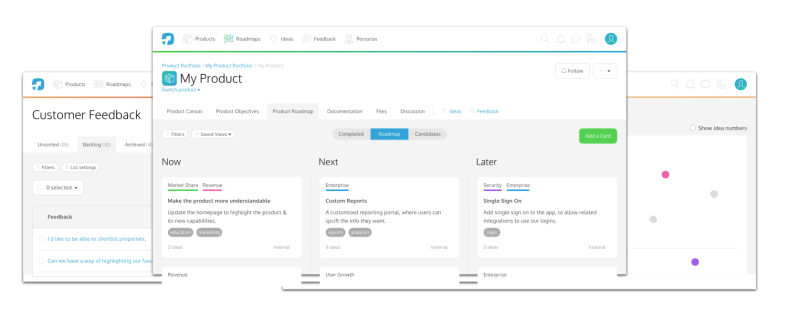
ProdPad is a product management tool focused on outcomes, it offers a dedicated Objectives and Key Results (OKRs) feature, aligning strategic goals with product development efforts.
Pros:
Transparency with roadmap integration.
Prevents aimless work by helping you set clear priorities.
Focuses on outcome not outputs.
Clear communication on strategy and direction.
Progress tracking and accountability.
Cons:
• Limited flexibility in the platform and the feature, which leaves little room for doing your own processes, and forces everyone to work the same way.• Allows linking key results to roadmap initiatives only (it does not allow linking to other product work such as opportunities, epics, features or tasks). 44
3. Aha!
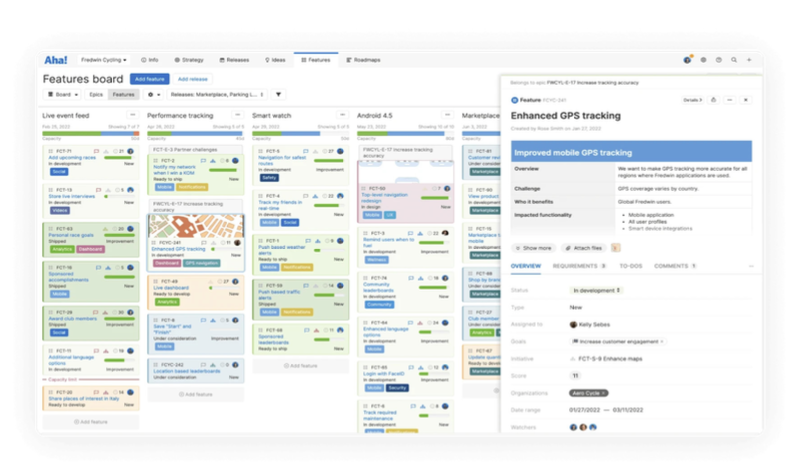
Aha! Roadmaps also offer a solution for managing Objectives and Key Results (OKRs) within your product management framework. This software's workspace hierarchy allows you to set objectives at various organizational levels, facilitating a cascading approach to OKR alignment.
Pros:
Allows for basic linking of OKRs and product work.
Allows teams to align their tasks and projects with overarching OKRs.
It can be used within Agile, Lean, or other methodologies.
Cons:
Limited flexibility with predefined fields and layouts that may not accommodate every organization's unique needs.
It still works from the premise that roadmaps are timelines.
The UI is difficult to understand and navigate.
Combines project and product management into the same discipline.
Dedicated OKR tools
These tools are purpose-built to handle Objectives and Key Results, offering a range of advanced features tailored to supercharge your OKR game. They can be convenient if you don't mind adding yet another tool to the ones your team uses. However, they are not without their faults, you will need to navigate the complexity and ensure that your OKRs are not living in isolation.
Pros and cons of dedicated OKR tools
Pros:
Advanced features: One of the stand-out advantages of dedicated OKR tools is their laser focus on OKRs. They come armed with a plethora of advanced features specifically designed to streamline the entire OKR process. From setting objectives to tracking key results and generating in-depth reports, these tools are engineered to handle it all. For product managers seeking a comprehensive and specialized solution, this is a good option.
Company-wide adoption: If your organization has already embraced a dedicated OKR tool, it's like having a common language across different departments. This consistency can be a game-changer, fostering a culture of alignment and goal-driven collaboration. When everyone is speaking the same OKR language, it's easier to ensure that the entire organization is marching in unison toward its strategic objectives.
Cons:
Isolated data: While dedicated OKR tools excel at managing OKRs, they might not play as nicely with your other product management workflows. Your OKRs often live in a separate ecosystem, detached from your roadmaps, feature development, and other essential processes. This segregation can hinder your ability to see the big picture, making it challenging to understand how your OKRs align with your broader product strategy. For product managers who thrive on holistic insights, this isolation can be a drawback.
Complexity: Some of these tools can be quite complex, loaded with features that might be overkill for your specific needs. This complexity can inadvertently introduce more bureaucracy into your workflow, making the OKR process feel heavy and cumbersome.
Examples of dedicated OKR tools
1. Lattice
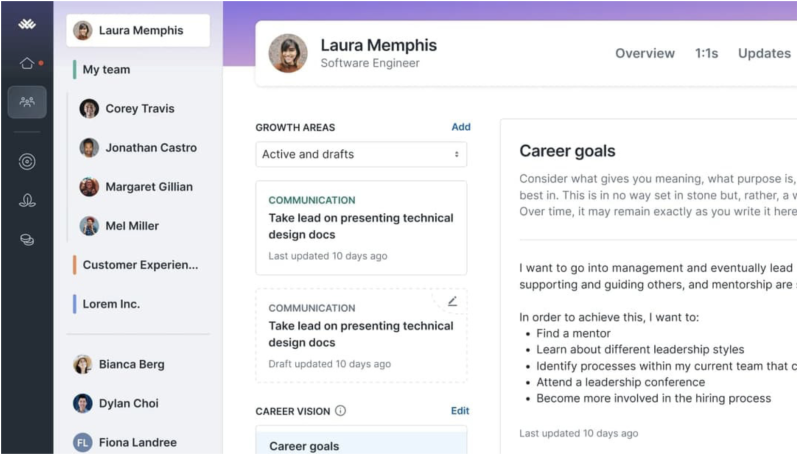
Lattice is a comprehensive OKR setting and tracking solution that includes features like custom dashboards, progress tracking, and reporting; it also offers a suite of employee development tools that can complement OKR tracking features to help employees grow while striving for company and team objectives. It’s fairly intuitive with a user-friendly UI. The company also offers personalized customer support to help you set up and configure the platform for your team. Barriers to using Lattice may include the cost, initial set-up, and complexity of features offered.
2. Microsoft Viva Goals
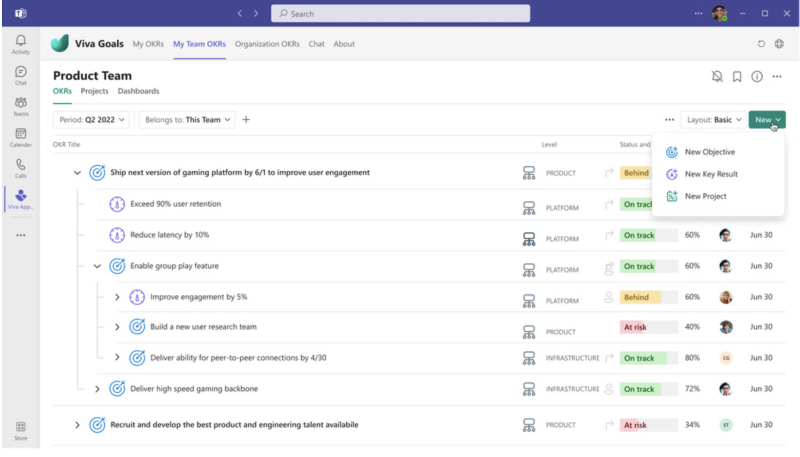
Microsoft Viva Goals is an efficient goal management platform with an intuitive OKR system for streamlined goal setting, tracking, and alignment, enhancing team collaboration and real-time progress monitoring. It offers robust analytics for data-driven decision-making and customizable reports. However, there's a learning curve for full utilization, making it better suited for experienced OKR users. It also has limited view options for data and may require additional effort for full tool integration, particularly with some preferred third-party applications.
3. Perdoo
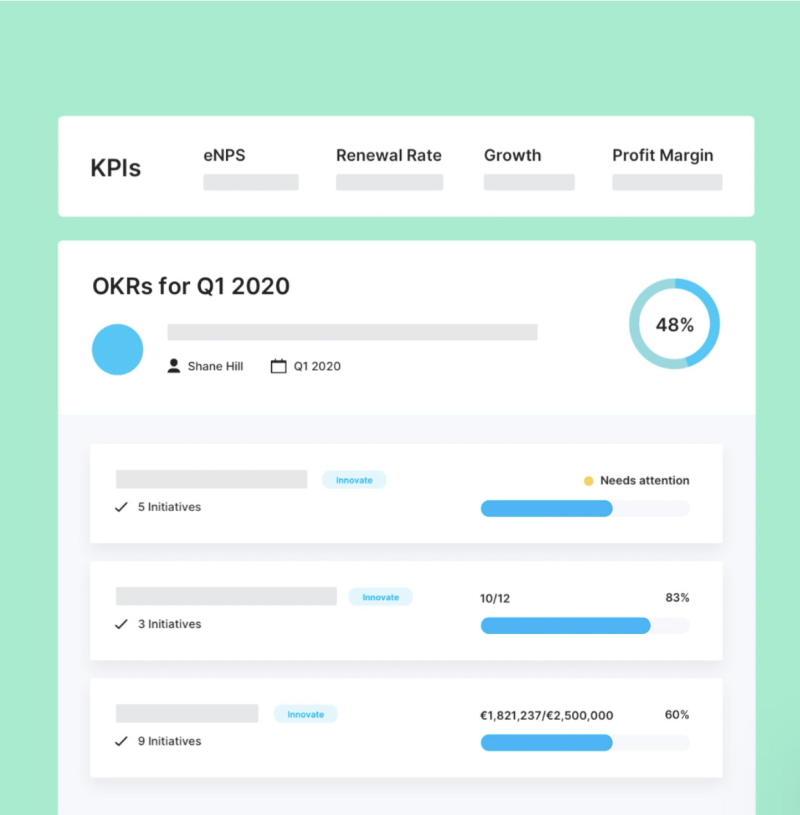
Perdoo is focused on performance management and is a comprehensive dedicated OKR tracking tool that helps you set, track, and manage OKRs with custom dashboards, real-time progress tracking, and automated reporting. It has a user-friendly UI and makes it easy to align your team’s goals and objectives in a transparent way, but the learning curve, cost, and complexity of features may be a barrier for some teams to adopt it as their primary OKR tool.
4. WorkBoard
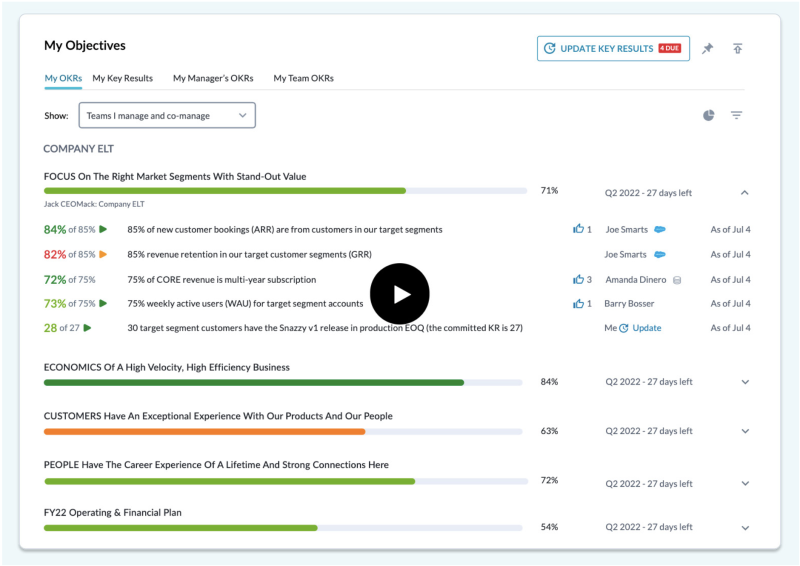
OKRs for High-Performing Product Teams Workboard markets itself as “the enterprise standard for OKRs and strategy execution”. It offers a full suite of features to set, align on, track, and communicate OKRs, and has received comments from users like, “Workboard allows us to achieve bigger goals faster.” While pricing information is not accessible on their current website (We're assuming you’d get into this after signing up for a demo), it’s an additional cost for teams to consider and another piece of software to bring into your workflow. However, some users commented on it not being very responsive and that it was hard to access support information.
Other tools:
Profit.co
Leapsome
15Five
Quantive
Peoplebox
Culture Amp
Weekdone
Inspire
When selecting a tool to use to set, track, and manage your OKRs, glean from the options out there and see what fits best in your unique context, whether you’re at a small, medium, or large company, whether you’re working remotely or in-office, whether you have a small or large budget, and whether you already use a tool that could do the job or want to bring in a new one to add horsepower in this area.
General-purpose OKR tools
General-purpose tools serve as a versatile and readily accessible option for product managers and teams. This category includes familiar platforms such as Google Docs, Sheets, Slides, Asana, Confluence, Miro, Notion, and Coda, among others. While these tools are not inherently designed for OKRs, they can serve as a cost-effective and straightforward solution to get started.
However, it's essential to weigh the pros and cons of utilizing these general-purpose tools, as they come with their own set of advantages and limitations tailored to the unique needs of product teams.
Pros and cons of general-purpose tools
Pros:
• Simplicity: General-purpose tools are renowned for their ease of use and quick setup. This simplicity makes them ideal for swiftly implementing OKRs without extensive onboarding or training, allowing teams to get started with minimal friction.
• Cost-effective: In a world where budget considerations often loom large, these tools offer a cost-effective option, and some are even available for free. This affordability can be a significant advantage, particularly for smaller product teams.
Cons:
• Lack of specialization: While these tools provide a straightforward approach to OKRs, they lack the specialized features and functionalities specifically tailored to OKR management. Over time, this limitation may become apparent as your OKR requirements evolve.
• Isolated data: General-purpose tools often compartmentalize your OKRs, keeping them separate from your broader product roadmaps and workflows. This separation can hinder your ability to see the complete picture and the interconnectedness of goals and tasks.
• Error-prone: General-purpose tools are more susceptible to human error, such as accidental data deletion or mismanagement, which can disrupt your OKR tracking and management efforts.
• Limited functionality: As your product team's OKR needs become more advanced and nuanced, general-purpose tools may struggle to keep pace. Their limited functionality might prove insufficient for accommodating the intricacies of evolving OKR strategies and measurements.
Examples of general-purpose tools
1. Google Docs
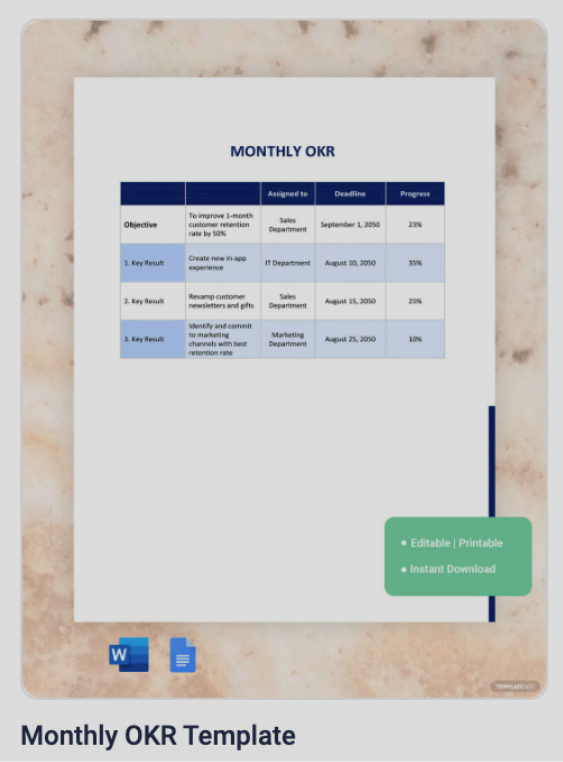
Probably the lowest bar in terms of access and ease of use along with spreadsheets, using Google Docs to set your OKRs can be very straightforward. We would say this tends to work better for smaller vs. larger organizations and is a good option if you’re looking to get your OKRs up and running quickly in a low-lift, cost-effective, bare-bones way.
Source: Template.net
2. Google Sheets

Similar to Google Docs, Google Sheets can be a really great, accessible way to get your OKRs up and running. While the design isn’t fancy the functionality is good and this format forces you to keep things simple. This can get complicated for sharing and dealing with comments from multiple stakeholders, though.
Here’s a free template from Perdoo.
Source: Perdoo
3. Confluence
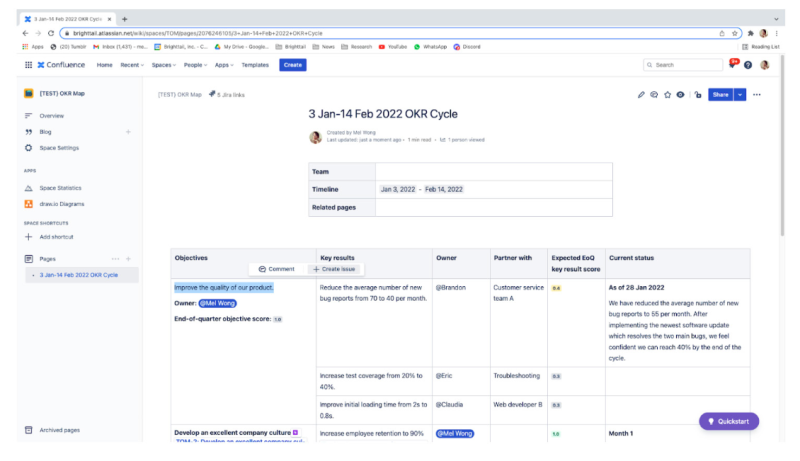
If your organization already uses Atlassian’s product suite (i.e Confluence, JIRA, Trello) this may be a great option to avoid having to introduce yet another tool for team members to learn and bring into your existing ecosystem.
It’s not as easily shareable as Google Docs and Sheets but can work well if you’re already using it as one of your main “hubs” in your organization.
Here’s a primer from Atlassian on how to set this up.
Source: Atlassian
4. Google Slides / PowerPoint

If the culture in your organization is to use slides to communicate ideas, this may be a good option for communicating your OKRs and affords you significantly more leeway on the design front to be creative and make your OKRs really shine.
They are easy to share in this format but can be challenging to reference if you don’t have the link or it’s not publicly posted in one of your main “hubs”.
Here are some free and paid templates.
Source: Slidesalad
5. Asana
Initially built to help teams manage and collaborate on projects, Asana launched additional functionality for tracking OKRs. The layout and design are excellent; the challenge is often getting others in your organization on Asana if they don’t already use it within their teams.
Source: VentureBeat.
6. Miro
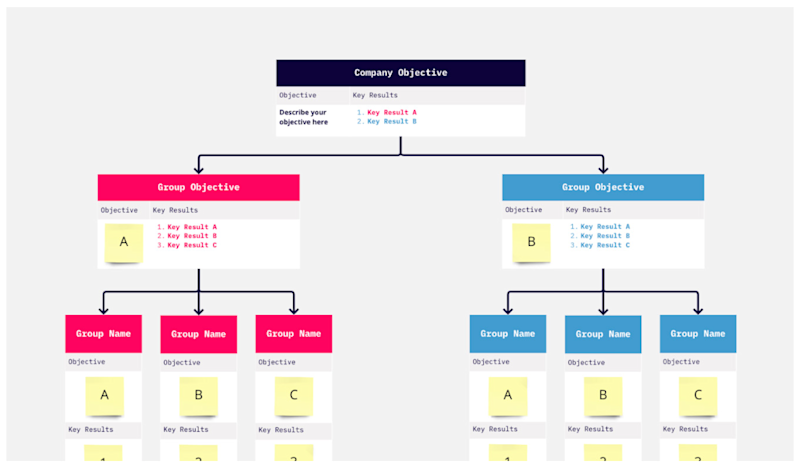
During the pandemic, many teams jumped aboard the Miro train. It’s fantastic for organizing information visually and as you would in real life with a whiteboard or bulletin board in the main area of your office. Miro has been a game-changer for remote work. It comes with similar challenges as Asana re: adoption from the larger team if your whole org isn’t already using it. Tracking progress might have to be done more creatively using this tool as well. They also recently launched new AI tools.
Source: Miro.
7. Notion
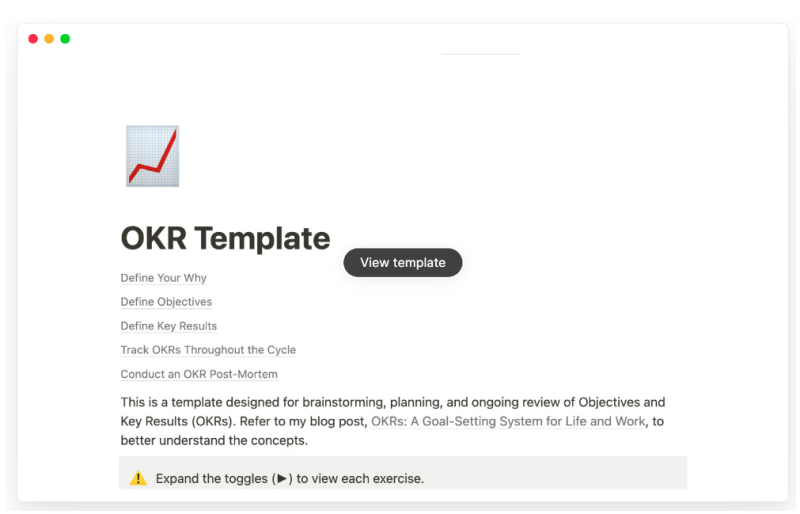
Notion has been picking up a lot of traction recently, with new feature rollouts like Notion AI that can automate functions and complete tasks, in addition to connecting with other services like Google Assistant, Siri, ChatGPT, and Bard.
Many companies have adopted Notion over Google Docs or Confluence as their main point of reference for documenting and sharing ideas. It’s an amazing tool that’s also really fun to use. If your team is already using Notion, capturing OKRs here would be a no-brainer.
Source: Notion.
8. Coda
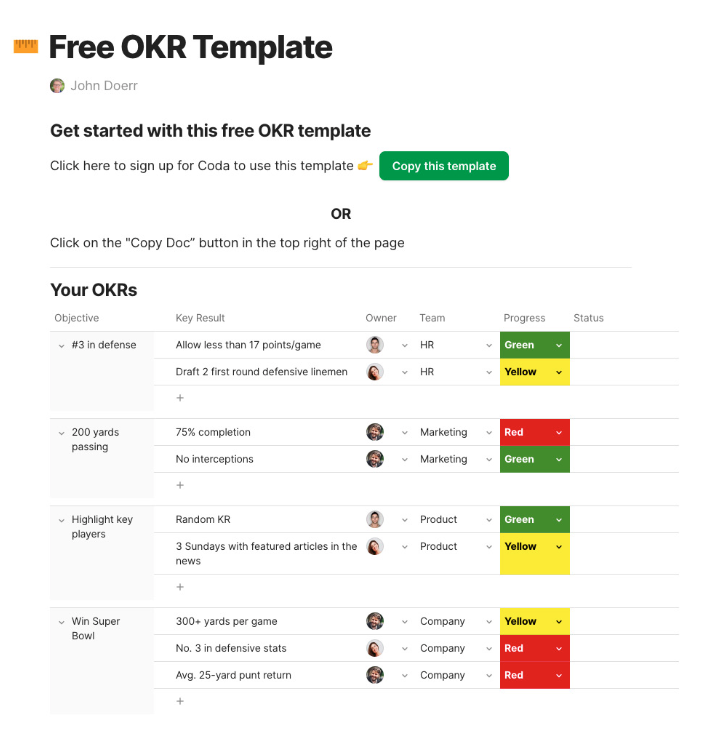
Coda markets itself as being “The evolution of docs. Simple. Familiar. But built to adapt to your team’s needs.” It functions as a set of building blocks with business templates for almost every need you could imagine, including OKRs, and links to what would otherwise be many siloed tools in one place. The friction of adopting a new tool still applies here if your team isn’t already using it.
Source: Coda
CHAPTER 8
OKR Case Studies
So far we’ve covered everything from what OKRs are, examples of good vs. bad OKRs, how to set, track, and measure them, and tools you can use to help you; however, we haven’t yet touched on what OKRs can actually look like at an organizational level with real-life impacts.
Here are some real-world product management case studies that show how OKRs and where you decide to put your focus can be both extremely powerful if done well and extremely harmful if handled poorly.
Success case studies
(See this video starting at the 8-minute mark)
In 2008 Googler Sundar Pichai was responsible for leading the development of Chrome and overseeing its launch in 2008. His vision for the browser was to create a faster, more secure, and more user-friendly browsing experience for users.
To do this, he set an objective: “Build the next generation client platform for the future of web applications” (In plain terms, “build the best browser”.) The key results that described the HOW behind this included focused on the number of users.
While he could have focused on engagement or ad clicks or a million other metrics, this metric was chosen, as John Doerr says, “Because users are going to decide if Chrome is a great browser or not.”
He had one three-year-long objective and every year he stuck to the same key results around the number of users but he adapted the metrics over time. In the first year, the goal was 20 million users, and got less than 10 million. In the second year, the bar was raised to 50 million and got to 37 million. In the third year, the bar was raised again to 100 million. To achieve this, they launched an aggressive marketing campaign, broader distribution, and improved the technology. They hit 111 million users.
Google Chrome surpassed other established browsers in terms of market share, becoming one of the most popular web browsers in the world (now with over 2 billion users) and the team has continued to focus on features and updates to help keep users engaged and satisfied.
This is an example of how carefully choosing an objective that is significant, concrete, action-oriented, and inspirational and key results that are specific and time-bound, aggressive yet realistic, measurable and verifiable can help to align teams around a shared sense of purpose, focus efforts on the most important things to reduce churn and distraction and take active steps toward the larger product vision and desired business outcomes.
Intel
Big companies began setting environmental objectives and targets in the late 1980s and early 1990s, as concerns about the impacts of climate change and environmental degradation increased.
The concept of corporate sustainability emerged during this time, with companies recognizing the importance of incorporating environmental and social considerations into their business strategies. One of the key drivers of this trend was the growing recognition that environmental risks and opportunities could have significant impacts on a company's reputation, financial performance, and long-term viability.
Companies also began to see environmental management as a way to improve operational efficiency, reduce costs, and enhance their brand value. In 1994, Intel became one of the first major companies to begin voluntary environmental reporting.
In 2010, they set an OKR around reducing its greenhouse gas emissions by 20% by the end of 2012 (a 2-year time-frame) compared to its emissions in 2007. The company exceeded this target, reducing its carbon footprint by 60% from 2007 levels, thanks to a range of energy efficiency improvements, renewable energy projects, and employee engagement programs. While we have a long way to go in terms of reducing our global carbon footprint, setting conscious OKRs is one way that we can align our efforts to achieve lower emissions.
Failure case studies
Sears
Originally founded in 1892 by Richard Warren Sears and Alvah Curtis Roebuck as a mail-order catalog business based in Chicago, Illinois, throughout the 20th century Sears grew to be one of the largest retailers in the world.
With more stores, diversified product offerings, and its own credit card that allowed customers to purchase items on credit and make payments over time, it was on track to continue doing well; however, in the 1990s the company faced competition from other retailers and struggled to keep up with changing consumer preferences and the rise of e-commerce.
Sears’ biggest competitor was Walmart which became the United States’ largest retailer in the 1990s. After a 2005 merger with Kmart failed to revitalize the business, on Oct 15, 2018, Sears filed for bankruptcy.
While a combination of factors led to its decline including a failure to execute on business strategy, it has been reported that the company often struggled with setting realistic and achievable goals, including setting overly ambitious financial targets that were difficult to achieve and did not account for the changing competitive and technological landscape.
It has also been reported that Sears struggled with objective alignment between individual and company-wide goals - essentially a failure to set, track, and adapt OKRs effectively.
One well-known example, as reported by Forbes was that management set a sales target for its auto repair staff at $147 per hour. To meet this goal, mechanics began to change their behavior in an unfavorable way - overcharging customers and performing repairs that were not necessary in order to meet their targets.
What initially started out as a team objective to feed into helping the company generate more revenue resulted in a customer relations crisis with Edward Brenna, the chairman at the time, admitting, “The goal-setting process for service advisers created an environment where mistakes did occur.”
Ford Pinto
The Ford Pinto story is a famous example of how poorly defined OKRs can lead to failure. In the 1970s, Ford developed the subcompact Pinto car in a mad dash in an effort to design a car that hit the objectives of weighing less than 2,000 pounds, selling for under $2,000 and that would hit the showroom floor by 1971.
To reach the cost target, Ford engineers made a design decision that resulted in disaster, they decided not to spend extra money to reinforce the fuel tank and instead place it in a vulnerable position behind the rear axle.
This decision resulted in the Pinto being highly susceptible to fires in the event of a rear-end collision.
(Notice that “safety” was not explicitly set as one of the OKR priorities.)
Despite internal warnings about safety, the executive team calculated that it would be cheaper to settle lawsuits related to accidents than to recall and retrofit the vehicles. This cost-benefit analysis was a result of poorly defined objectives and incentives.
By focusing too much on cost reduction and sales targets, executives left a huge blind- spot - the broader impact of their decisions on customer safety. Fiery rear-end crashes ended up causing 53 deaths, numerous injuries, and a string of costly lawsuits. This case is an important reminder that safety and ethics should always be considered when setting OKRs, no matter how big or small your company is.
CHAPTER 9
Conclusion
By understanding what OKRs are, how they evolved, how they have been used by established teams big and small to achieve desired business and customer outcomes, how to set your own OKRs and the essential context you need to do so, how to communicate and align OKRs cross-functionally across teams, how to measure OKRs within your organization, and the common pitfalls to avoid.
By completing this guide, you’ve set yourself up well for success! However, because OKRs are set based on variables related to your business, the market, and customers, don’t consider every OKR you define to be set in stone.
It’s important to always stay on your toes and be ready to adapt if conditions change. Most importantly, every OKR you set should be done with intention and connection to action.
Carefully selecting your OKRs can lead to success, and on the flip side, setting OKRs in a siloed fashion that does not consider safety and ethical implications or that doesn’t look at the bigger picture holistically can lead to failure.
There are many tools that can help you organize OKRs within your organization, including airfocus, which offers tools to help you set and track OKRs, connect individual roadmap items to OKRs, collaborate with team members, and see everything in one place.
Additional resources
Here are some additional resources to help you continue your learning and have an immediate actionable impact on your organization:
Why the Secret to Success is Setting the Right Goals: John Doerr TED Talk
“How Do I Know If The Product I’m Working On is On Track to Do Well?”

Too busy?
Download now & read later.
Get the PDF